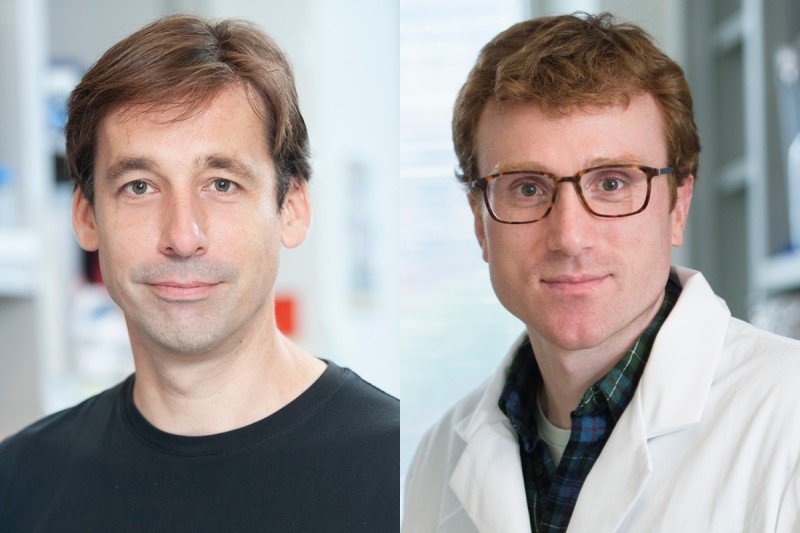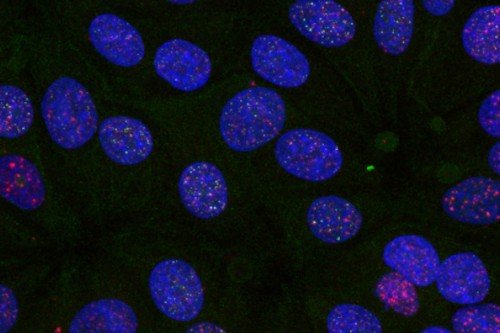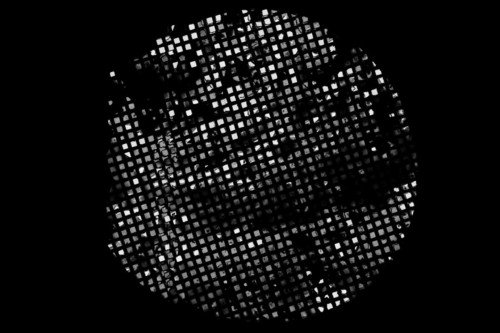
Dirk Remus and Richard Hite
DNA is often likened to a blueprint. The particular sequence of As, Cs, Gs, and Ts in DNA provides information for building an organism.
What’s not captured by this analogy is the fact that our DNA requires constant upkeep to maintain its integrity. Were it not for dedicated DNA repair machinery that routinely fixes mistakes, the information within DNA would be rapidly degraded.
This repair happens at cell cycle checkpoints that are activated in response to DNA damage. Like a quality assurance agent on an assembly line, proteins that participate in the DNA damage checkpoint assess the cell’s DNA for mistakes and, if necessary, pause cell division and make repairs. When this checkpoint breaks down — which can happen as a result of genetic mutations — DNA damage builds up, and the result is often cancer.
Though scientists have learned much about DNA damage and repair over the past 50 years, important outstanding questions remain. One particularly bedeviling puzzle is how a repair protein called the 9-1-1 clamp — a DNA damage “first responder” — attaches itself to the site of a broken DNA strand to activate of the DNA damage checkpoint.
“We know that this attachment is a pivotal step necessary for initiating an effective repair program,” says Dirk Remus, a molecular biologist at the Sloan Kettering Institute (SKI) who studies the fundamentals of DNA replication and repair. “But the mechanisms involved are completely obscure.”
Now, thanks to a collaboration between Dr. Remus’ lab and that of SKI structural biologist Richard Hite, a clear picture of how the 9-1-1 clamp is recruited to sites of DNA damage has emerged. The results, which challenge conventional wisdom in the field, were published March 21, 2022, in the journal Nature Structural and Molecular Biology.
Complementary Expertise Yields Surprising Results
The startling discoveries grew out of a collaboration between two labs with complementary expertise. Dr. Remus’ lab uses biochemical methods to study the process of DNA replication and repair. A primary goal of his research over the past several years has been to reconstitute the entire DNA replication-and-repair process in a test tube, apart from a surrounding cell.
As a result of this effort, his lab has purified several components of the repair machinery, including 9-1-1 proteins and proteins that facilitate the binding of 9-1-1 to DNA.
Dr. Remus realized that if these complexes could be viewed at atomic resolution, they would provide a set of freeze-frame images of the individual steps in the repair process. That’s when he turned to Dr. Hite’s lab for help.
“I said, ‘We have this complex; can you help us determine its molecular structure to figure out how it works?’ And that’s what he did.”
Dr. Hite is a structural biologist with expertise in using a technique called cryo-electron microscopy (cryo-EM), which enables the study of proteins and protein assemblies by visualizing their fine-grain movements at resolutions that can reveal the positions of individual amino acids within the proteins. Much like the gears and levers of a machine, it’s these movements of amino acids that allow proteins to serve as the workhorses of the cell, including those that repair DNA.
“When Dirk came to us, we realized that many of the tools that our lab has developed over the past few years were perfectly suited to answering this question,” Dr. Hite says. “Using cryo-EM, we’re able to not only determine one structure but an ensemble of structures. By putting these structures together in a logical pattern, based on the new data and previous biochemical data, we can come up with a proposal for how this clamp works.”
They did, and the results were surprising.
“The model we developed had interesting features that contradicted what had been previously thought to be the way these types of clamps are being loaded onto DNA,” Dr. Hite says.
“When Rich first produced the structure, I thought he got it wrong because it was against all the expectations,” Dr. Remus adds. “Now, in hindsight, it all makes perfect sense.”
A New Model for Opening and Closing a DNA Clamp Around DNA
The 9-1-1 clamp is shaped like a ring. To carry out its function, it needs to surround the broken DNA at the junction between an exposed end of one strand of a double-stranded piece of DNA abutting a single-stranded one. Consequently, the ring structure of the 9-1-1 clamp must open to allow the single-stranded DNA to swing into the center of the clamp and then reclose around it. This does not occur spontaneously but is facilitated by another protein complex, called the clamp loader complex.
“It had been thought from all studies prior to this that clamps would open in the manner of lock washer, where basically the two open ends of the clamp would rotate out of plane to create a narrow gap,” Dr. Remus says. “But what Rich observed is that the 9-1-1 clamp opens much more widely than anticipated, and it opens completely in plane — there’s no twisting like in the lock-washer scenario.”
The scientists point out that the lock-washer model has been around for two decades and has been the guiding paradigm in the field for how a clamp gets loaded around DNA. But in this case, it’s wrong.
Another surprise was that the 9-1-1 clamp loader complex was observed to bind DNA in the opposite orientation from other clamp loader complexes that act on undamaged DNA during normal DNA replication. This observation explained how 9-1-1 is specifically recruited to sites of DNA damage.
From Basic to Translational Research
Aside from providing a satisfying answer to a fundamental biological puzzle, Dr. Remus thinks the research may eventually lead to better cancer drugs.
Many existing chemotherapy drugs work by interfering with DNA replication of cancer cells and generating the type of DNA damage that is normally fixed by repair processes elicited by the 9-1-1 clamp. Because cancer cells already have a reduced ability to repair DNA damage, the addition of DNA-damaging chemotherapy drugs can overwhelm the cells’ ability to fix their DNA, and so they die. (This is how drugs called PARP inhibitors work, for example.)
With this new knowledge about how 9-1-1 interacts with other repair proteins and with DNA, scientists could potentially design drugs that interfere specifically with this step of the repair process, making chemotherapy drugs even more effective.
“One of the great things about working here at SKI is that a basic scientist’s research can be the starting point for translational studies that ultimately lead to better treatments,” Dr. Hite says.
- Repairing broken DNA is an important part of maintaining the integrity of genetic instructions; cancer results when damaged DNA goes unrepaired
- Broken DNA is repaired at cell cycle checkpoints that are activated by DNA damage.
- Using a combination of biochemical methods and cryo-electron microscopy, SKI researchers solved a key part of how the DNA repair process works.
- They figured out how a protein clamp called 9-1-1 is loaded onto broken DNA.





